Analyzing Staff Retention Strategies in a Business Project Report
VerifiedAdded on 2022/11/24
|27
|5579
|368
Report
AI Summary
This report examines staff retention strategies within the context of a business project, focusing on the case of Sollatek. The report begins with an introduction outlining the importance of staff retention as a key component of talent management, followed by an analysis of the aims, objectives, and research questions related to staff retention strategies. A comprehensive literature review provides a foundation for understanding the concepts and strategies. The project management plan details time, cost, quality, scope, risk, and resources. The work breakdown structure (WBS) and Gantt chart are used to organize the project. The report also covers small-scale qualitative and quantitative research, data analysis techniques, and provides recommendations for improving staff retention. The report concludes with a reflection on the values undertaken during the research.
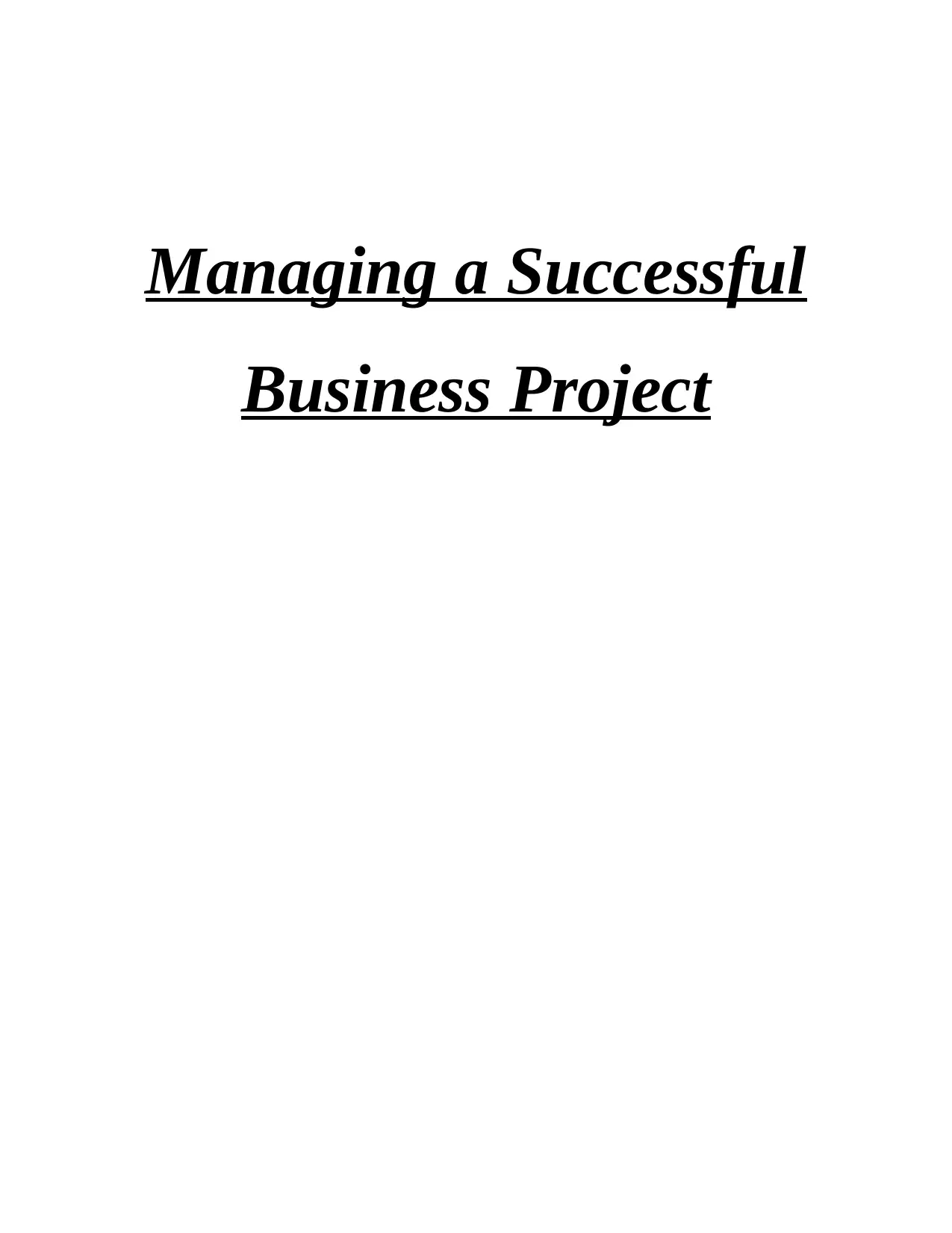
Managing a Successful
Business Project
Business Project
Paraphrase This Document
Need a fresh take? Get an instant paraphrase of this document with our AI Paraphraser
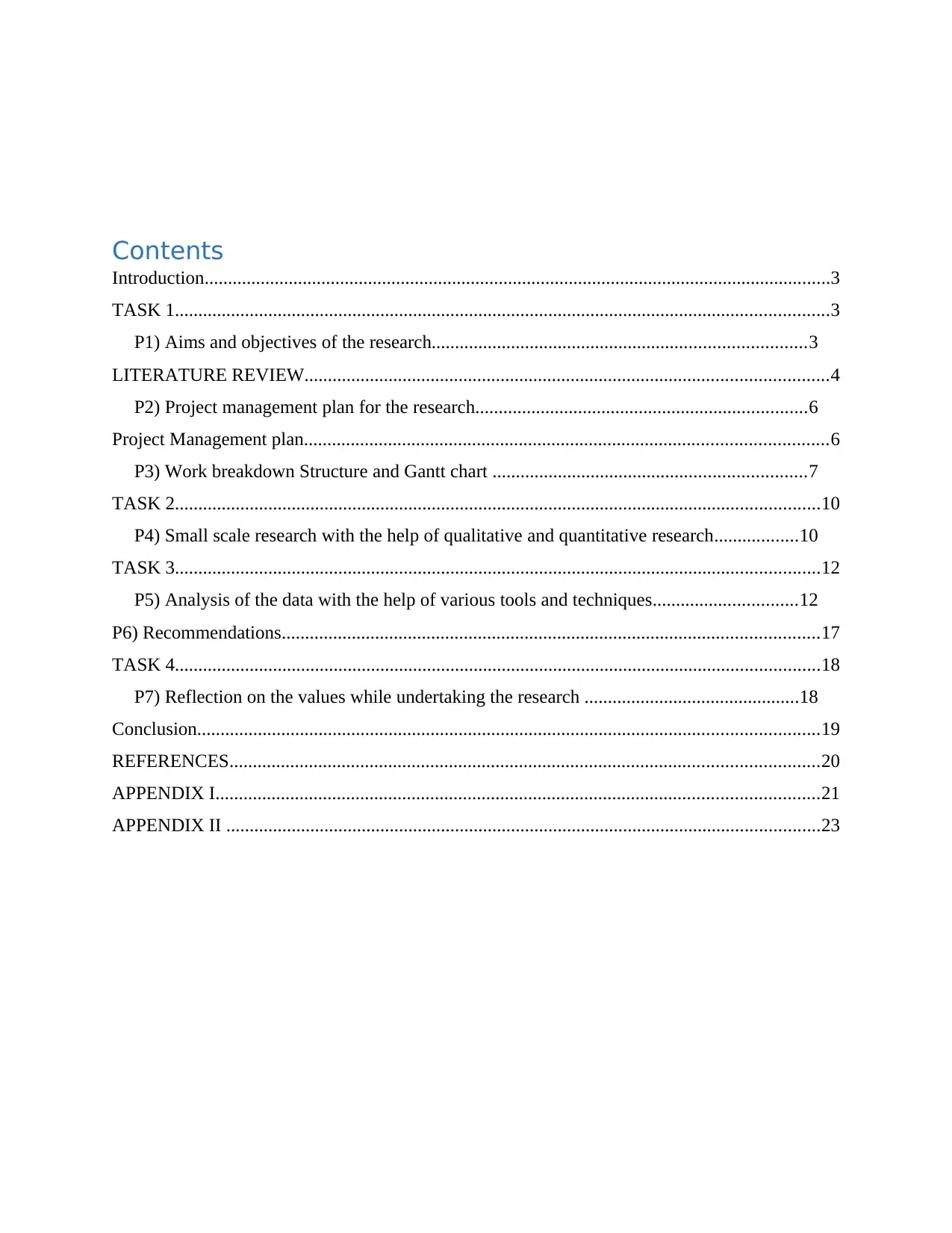
Contents
Introduction......................................................................................................................................3
TASK 1............................................................................................................................................3
P1) Aims and objectives of the research................................................................................3
LITERATURE REVIEW................................................................................................................4
P2) Project management plan for the research.......................................................................6
Project Management plan................................................................................................................6
P3) Work breakdown Structure and Gantt chart ...................................................................7
TASK 2..........................................................................................................................................10
P4) Small scale research with the help of qualitative and quantitative research..................10
TASK 3..........................................................................................................................................12
P5) Analysis of the data with the help of various tools and techniques...............................12
P6) Recommendations...................................................................................................................17
TASK 4..........................................................................................................................................18
P7) Reflection on the values while undertaking the research ..............................................18
Conclusion.....................................................................................................................................19
REFERENCES..............................................................................................................................20
APPENDIX I.................................................................................................................................21
APPENDIX II ...............................................................................................................................23
Introduction......................................................................................................................................3
TASK 1............................................................................................................................................3
P1) Aims and objectives of the research................................................................................3
LITERATURE REVIEW................................................................................................................4
P2) Project management plan for the research.......................................................................6
Project Management plan................................................................................................................6
P3) Work breakdown Structure and Gantt chart ...................................................................7
TASK 2..........................................................................................................................................10
P4) Small scale research with the help of qualitative and quantitative research..................10
TASK 3..........................................................................................................................................12
P5) Analysis of the data with the help of various tools and techniques...............................12
P6) Recommendations...................................................................................................................17
TASK 4..........................................................................................................................................18
P7) Reflection on the values while undertaking the research ..............................................18
Conclusion.....................................................................................................................................19
REFERENCES..............................................................................................................................20
APPENDIX I.................................................................................................................................21
APPENDIX II ...............................................................................................................................23
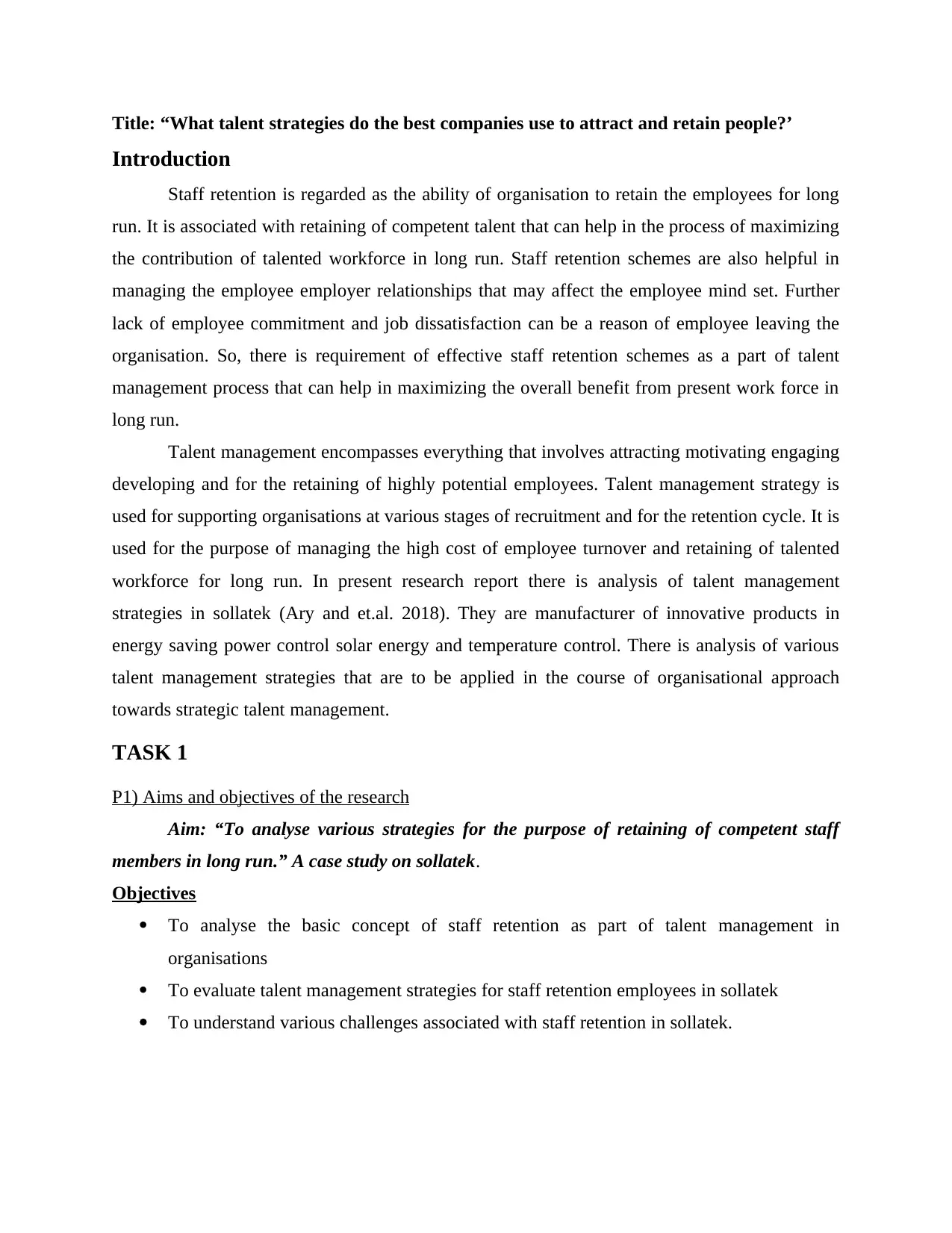
Title: “What talent strategies do the best companies use to attract and retain people?’
Introduction
Staff retention is regarded as the ability of organisation to retain the employees for long
run. It is associated with retaining of competent talent that can help in the process of maximizing
the contribution of talented workforce in long run. Staff retention schemes are also helpful in
managing the employee employer relationships that may affect the employee mind set. Further
lack of employee commitment and job dissatisfaction can be a reason of employee leaving the
organisation. So, there is requirement of effective staff retention schemes as a part of talent
management process that can help in maximizing the overall benefit from present work force in
long run.
Talent management encompasses everything that involves attracting motivating engaging
developing and for the retaining of highly potential employees. Talent management strategy is
used for supporting organisations at various stages of recruitment and for the retention cycle. It is
used for the purpose of managing the high cost of employee turnover and retaining of talented
workforce for long run. In present research report there is analysis of talent management
strategies in sollatek (Ary and et.al. 2018). They are manufacturer of innovative products in
energy saving power control solar energy and temperature control. There is analysis of various
talent management strategies that are to be applied in the course of organisational approach
towards strategic talent management.
TASK 1
P1) Aims and objectives of the research
Aim: “To analyse various strategies for the purpose of retaining of competent staff
members in long run.” A case study on sollatek.
Objectives
To analyse the basic concept of staff retention as part of talent management in
organisations
To evaluate talent management strategies for staff retention employees in sollatek
To understand various challenges associated with staff retention in sollatek.
Introduction
Staff retention is regarded as the ability of organisation to retain the employees for long
run. It is associated with retaining of competent talent that can help in the process of maximizing
the contribution of talented workforce in long run. Staff retention schemes are also helpful in
managing the employee employer relationships that may affect the employee mind set. Further
lack of employee commitment and job dissatisfaction can be a reason of employee leaving the
organisation. So, there is requirement of effective staff retention schemes as a part of talent
management process that can help in maximizing the overall benefit from present work force in
long run.
Talent management encompasses everything that involves attracting motivating engaging
developing and for the retaining of highly potential employees. Talent management strategy is
used for supporting organisations at various stages of recruitment and for the retention cycle. It is
used for the purpose of managing the high cost of employee turnover and retaining of talented
workforce for long run. In present research report there is analysis of talent management
strategies in sollatek (Ary and et.al. 2018). They are manufacturer of innovative products in
energy saving power control solar energy and temperature control. There is analysis of various
talent management strategies that are to be applied in the course of organisational approach
towards strategic talent management.
TASK 1
P1) Aims and objectives of the research
Aim: “To analyse various strategies for the purpose of retaining of competent staff
members in long run.” A case study on sollatek.
Objectives
To analyse the basic concept of staff retention as part of talent management in
organisations
To evaluate talent management strategies for staff retention employees in sollatek
To understand various challenges associated with staff retention in sollatek.
⊘ This is a preview!⊘
Do you want full access?
Subscribe today to unlock all pages.

Trusted by 1+ million students worldwide
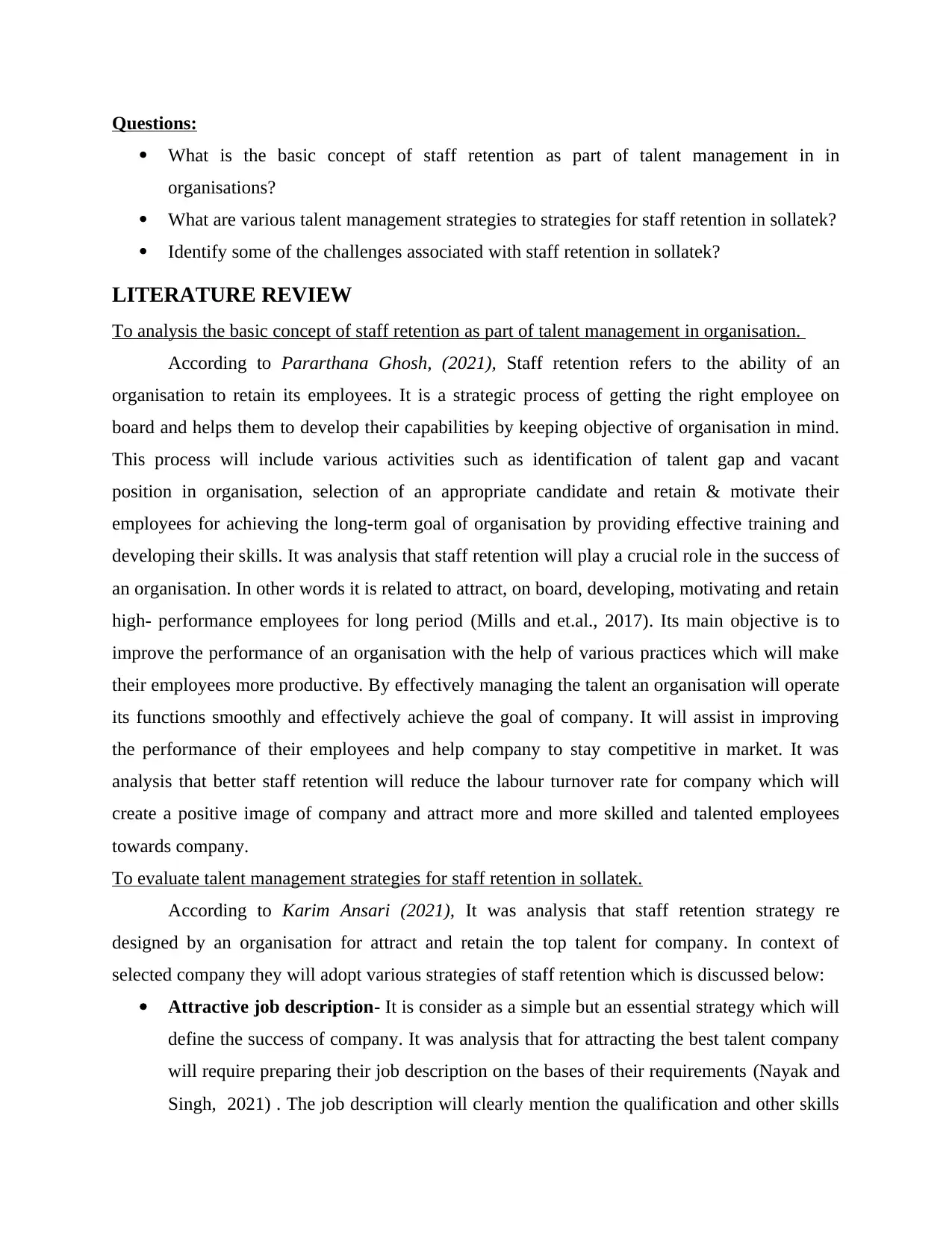
Questions:
What is the basic concept of staff retention as part of talent management in in
organisations?
What are various talent management strategies to strategies for staff retention in sollatek?
Identify some of the challenges associated with staff retention in sollatek?
LITERATURE REVIEW
To analysis the basic concept of staff retention as part of talent management in organisation.
According to Pararthana Ghosh, (2021), Staff retention refers to the ability of an
organisation to retain its employees. It is a strategic process of getting the right employee on
board and helps them to develop their capabilities by keeping objective of organisation in mind.
This process will include various activities such as identification of talent gap and vacant
position in organisation, selection of an appropriate candidate and retain & motivate their
employees for achieving the long-term goal of organisation by providing effective training and
developing their skills. It was analysis that staff retention will play a crucial role in the success of
an organisation. In other words it is related to attract, on board, developing, motivating and retain
high- performance employees for long period (Mills and et.al., 2017). Its main objective is to
improve the performance of an organisation with the help of various practices which will make
their employees more productive. By effectively managing the talent an organisation will operate
its functions smoothly and effectively achieve the goal of company. It will assist in improving
the performance of their employees and help company to stay competitive in market. It was
analysis that better staff retention will reduce the labour turnover rate for company which will
create a positive image of company and attract more and more skilled and talented employees
towards company.
To evaluate talent management strategies for staff retention in sollatek.
According to Karim Ansari (2021), It was analysis that staff retention strategy re
designed by an organisation for attract and retain the top talent for company. In context of
selected company they will adopt various strategies of staff retention which is discussed below:
Attractive job description- It is consider as a simple but an essential strategy which will
define the success of company. It was analysis that for attracting the best talent company
will require preparing their job description on the bases of their requirements (Nayak and
Singh, 2021) . The job description will clearly mention the qualification and other skills
What is the basic concept of staff retention as part of talent management in in
organisations?
What are various talent management strategies to strategies for staff retention in sollatek?
Identify some of the challenges associated with staff retention in sollatek?
LITERATURE REVIEW
To analysis the basic concept of staff retention as part of talent management in organisation.
According to Pararthana Ghosh, (2021), Staff retention refers to the ability of an
organisation to retain its employees. It is a strategic process of getting the right employee on
board and helps them to develop their capabilities by keeping objective of organisation in mind.
This process will include various activities such as identification of talent gap and vacant
position in organisation, selection of an appropriate candidate and retain & motivate their
employees for achieving the long-term goal of organisation by providing effective training and
developing their skills. It was analysis that staff retention will play a crucial role in the success of
an organisation. In other words it is related to attract, on board, developing, motivating and retain
high- performance employees for long period (Mills and et.al., 2017). Its main objective is to
improve the performance of an organisation with the help of various practices which will make
their employees more productive. By effectively managing the talent an organisation will operate
its functions smoothly and effectively achieve the goal of company. It will assist in improving
the performance of their employees and help company to stay competitive in market. It was
analysis that better staff retention will reduce the labour turnover rate for company which will
create a positive image of company and attract more and more skilled and talented employees
towards company.
To evaluate talent management strategies for staff retention in sollatek.
According to Karim Ansari (2021), It was analysis that staff retention strategy re
designed by an organisation for attract and retain the top talent for company. In context of
selected company they will adopt various strategies of staff retention which is discussed below:
Attractive job description- It is consider as a simple but an essential strategy which will
define the success of company. It was analysis that for attracting the best talent company
will require preparing their job description on the bases of their requirements (Nayak and
Singh, 2021) . The job description will clearly mention the qualification and other skills
Paraphrase This Document
Need a fresh take? Get an instant paraphrase of this document with our AI Paraphraser
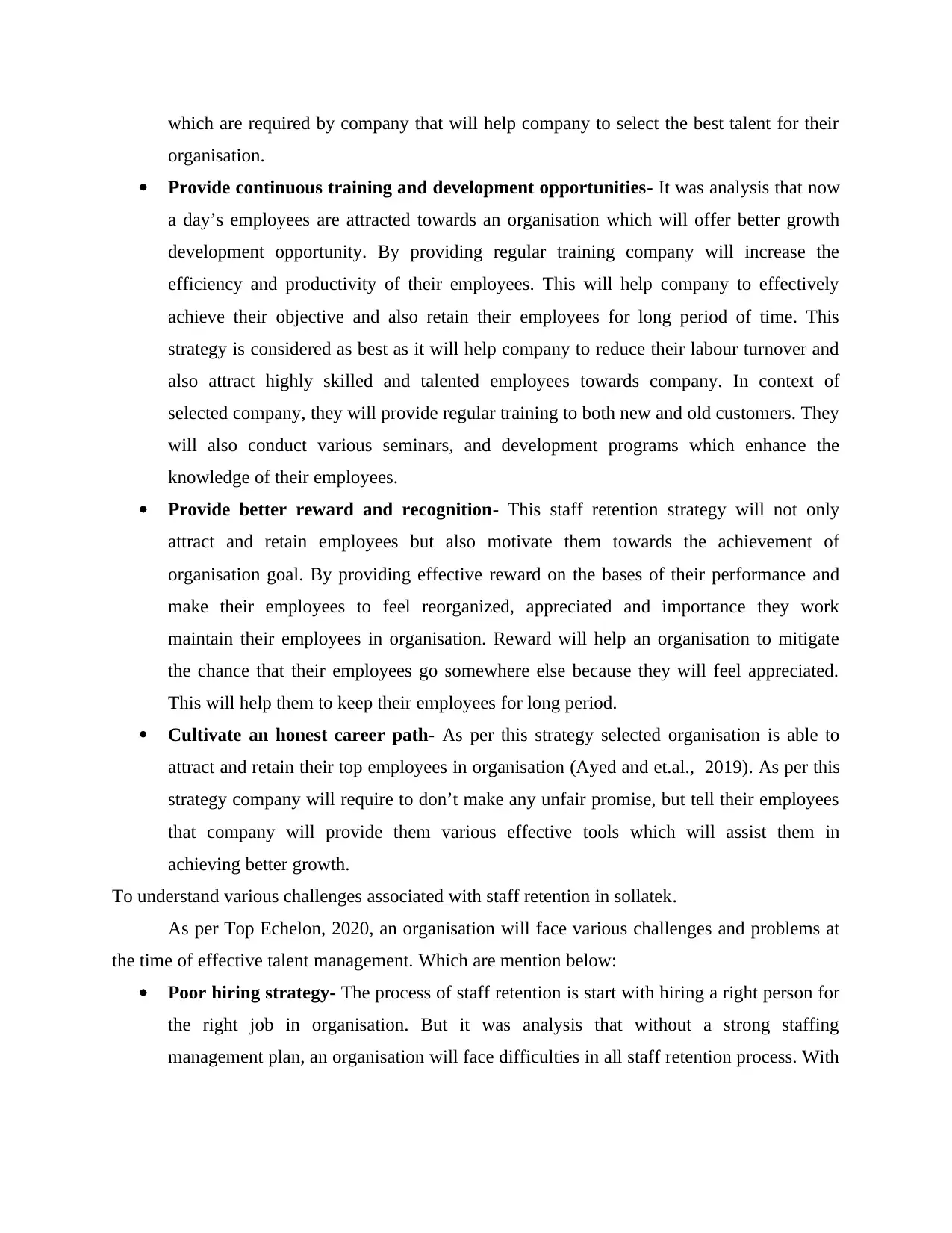
which are required by company that will help company to select the best talent for their
organisation.
Provide continuous training and development opportunities- It was analysis that now
a day’s employees are attracted towards an organisation which will offer better growth
development opportunity. By providing regular training company will increase the
efficiency and productivity of their employees. This will help company to effectively
achieve their objective and also retain their employees for long period of time. This
strategy is considered as best as it will help company to reduce their labour turnover and
also attract highly skilled and talented employees towards company. In context of
selected company, they will provide regular training to both new and old customers. They
will also conduct various seminars, and development programs which enhance the
knowledge of their employees.
Provide better reward and recognition- This staff retention strategy will not only
attract and retain employees but also motivate them towards the achievement of
organisation goal. By providing effective reward on the bases of their performance and
make their employees to feel reorganized, appreciated and importance they work
maintain their employees in organisation. Reward will help an organisation to mitigate
the chance that their employees go somewhere else because they will feel appreciated.
This will help them to keep their employees for long period.
Cultivate an honest career path- As per this strategy selected organisation is able to
attract and retain their top employees in organisation (Ayed and et.al., 2019). As per this
strategy company will require to don’t make any unfair promise, but tell their employees
that company will provide them various effective tools which will assist them in
achieving better growth.
To understand various challenges associated with staff retention in sollatek.
As per Top Echelon, 2020, an organisation will face various challenges and problems at
the time of effective talent management. Which are mention below:
Poor hiring strategy- The process of staff retention is start with hiring a right person for
the right job in organisation. But it was analysis that without a strong staffing
management plan, an organisation will face difficulties in all staff retention process. With
organisation.
Provide continuous training and development opportunities- It was analysis that now
a day’s employees are attracted towards an organisation which will offer better growth
development opportunity. By providing regular training company will increase the
efficiency and productivity of their employees. This will help company to effectively
achieve their objective and also retain their employees for long period of time. This
strategy is considered as best as it will help company to reduce their labour turnover and
also attract highly skilled and talented employees towards company. In context of
selected company, they will provide regular training to both new and old customers. They
will also conduct various seminars, and development programs which enhance the
knowledge of their employees.
Provide better reward and recognition- This staff retention strategy will not only
attract and retain employees but also motivate them towards the achievement of
organisation goal. By providing effective reward on the bases of their performance and
make their employees to feel reorganized, appreciated and importance they work
maintain their employees in organisation. Reward will help an organisation to mitigate
the chance that their employees go somewhere else because they will feel appreciated.
This will help them to keep their employees for long period.
Cultivate an honest career path- As per this strategy selected organisation is able to
attract and retain their top employees in organisation (Ayed and et.al., 2019). As per this
strategy company will require to don’t make any unfair promise, but tell their employees
that company will provide them various effective tools which will assist them in
achieving better growth.
To understand various challenges associated with staff retention in sollatek.
As per Top Echelon, 2020, an organisation will face various challenges and problems at
the time of effective talent management. Which are mention below:
Poor hiring strategy- The process of staff retention is start with hiring a right person for
the right job in organisation. But it was analysis that without a strong staffing
management plan, an organisation will face difficulties in all staff retention process. With
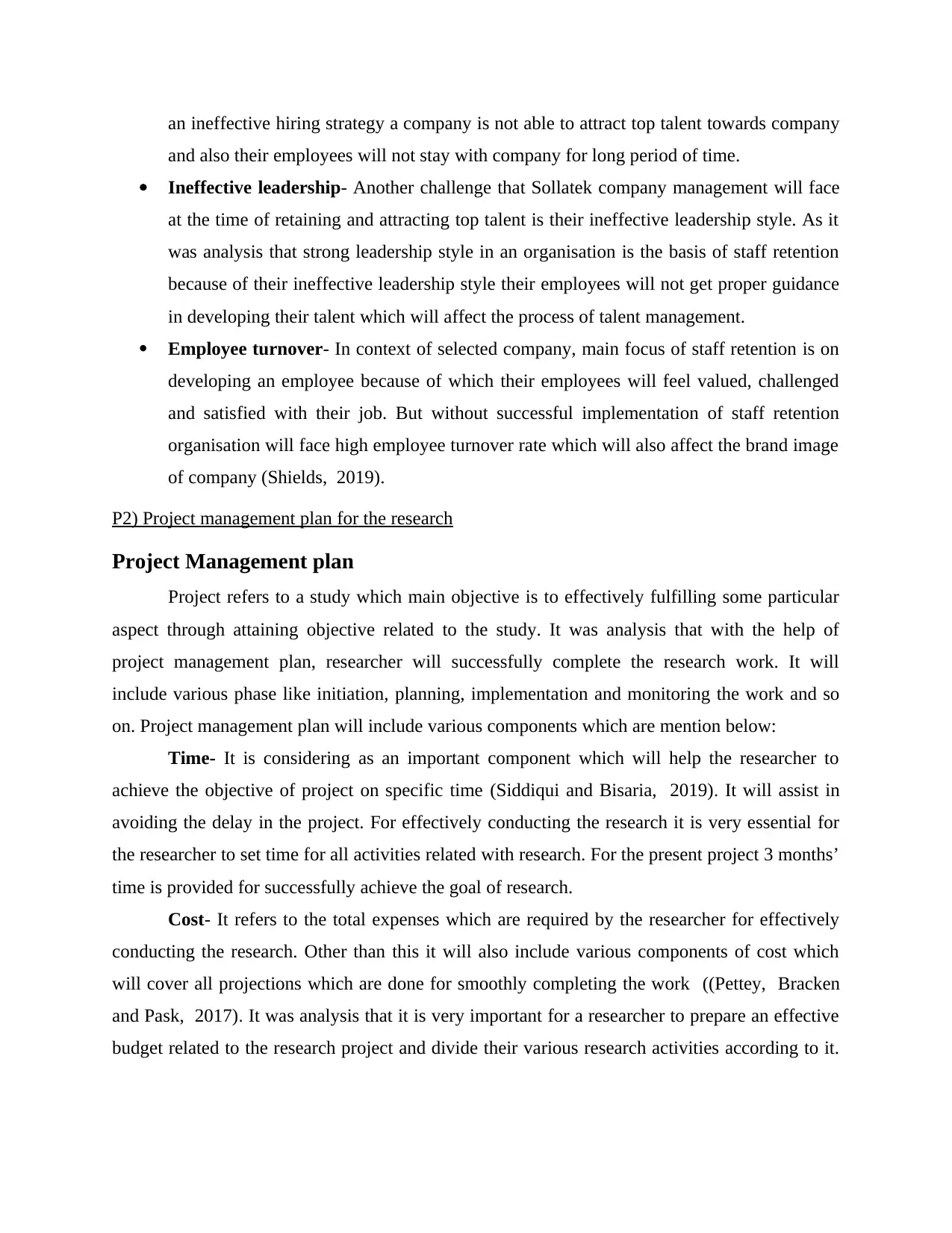
an ineffective hiring strategy a company is not able to attract top talent towards company
and also their employees will not stay with company for long period of time.
Ineffective leadership- Another challenge that Sollatek company management will face
at the time of retaining and attracting top talent is their ineffective leadership style. As it
was analysis that strong leadership style in an organisation is the basis of staff retention
because of their ineffective leadership style their employees will not get proper guidance
in developing their talent which will affect the process of talent management.
Employee turnover- In context of selected company, main focus of staff retention is on
developing an employee because of which their employees will feel valued, challenged
and satisfied with their job. But without successful implementation of staff retention
organisation will face high employee turnover rate which will also affect the brand image
of company (Shields, 2019).
P2) Project management plan for the research
Project Management plan
Project refers to a study which main objective is to effectively fulfilling some particular
aspect through attaining objective related to the study. It was analysis that with the help of
project management plan, researcher will successfully complete the research work. It will
include various phase like initiation, planning, implementation and monitoring the work and so
on. Project management plan will include various components which are mention below:
Time- It is considering as an important component which will help the researcher to
achieve the objective of project on specific time (Siddiqui and Bisaria, 2019). It will assist in
avoiding the delay in the project. For effectively conducting the research it is very essential for
the researcher to set time for all activities related with research. For the present project 3 months’
time is provided for successfully achieve the goal of research.
Cost- It refers to the total expenses which are required by the researcher for effectively
conducting the research. Other than this it will also include various components of cost which
will cover all projections which are done for smoothly completing the work ((Pettey, Bracken
and Pask, 2017). It was analysis that it is very important for a researcher to prepare an effective
budget related to the research project and divide their various research activities according to it.
and also their employees will not stay with company for long period of time.
Ineffective leadership- Another challenge that Sollatek company management will face
at the time of retaining and attracting top talent is their ineffective leadership style. As it
was analysis that strong leadership style in an organisation is the basis of staff retention
because of their ineffective leadership style their employees will not get proper guidance
in developing their talent which will affect the process of talent management.
Employee turnover- In context of selected company, main focus of staff retention is on
developing an employee because of which their employees will feel valued, challenged
and satisfied with their job. But without successful implementation of staff retention
organisation will face high employee turnover rate which will also affect the brand image
of company (Shields, 2019).
P2) Project management plan for the research
Project Management plan
Project refers to a study which main objective is to effectively fulfilling some particular
aspect through attaining objective related to the study. It was analysis that with the help of
project management plan, researcher will successfully complete the research work. It will
include various phase like initiation, planning, implementation and monitoring the work and so
on. Project management plan will include various components which are mention below:
Time- It is considering as an important component which will help the researcher to
achieve the objective of project on specific time (Siddiqui and Bisaria, 2019). It will assist in
avoiding the delay in the project. For effectively conducting the research it is very essential for
the researcher to set time for all activities related with research. For the present project 3 months’
time is provided for successfully achieve the goal of research.
Cost- It refers to the total expenses which are required by the researcher for effectively
conducting the research. Other than this it will also include various components of cost which
will cover all projections which are done for smoothly completing the work ((Pettey, Bracken
and Pask, 2017). It was analysis that it is very important for a researcher to prepare an effective
budget related to the research project and divide their various research activities according to it.
⊘ This is a preview!⊘
Do you want full access?
Subscribe today to unlock all pages.

Trusted by 1+ million students worldwide
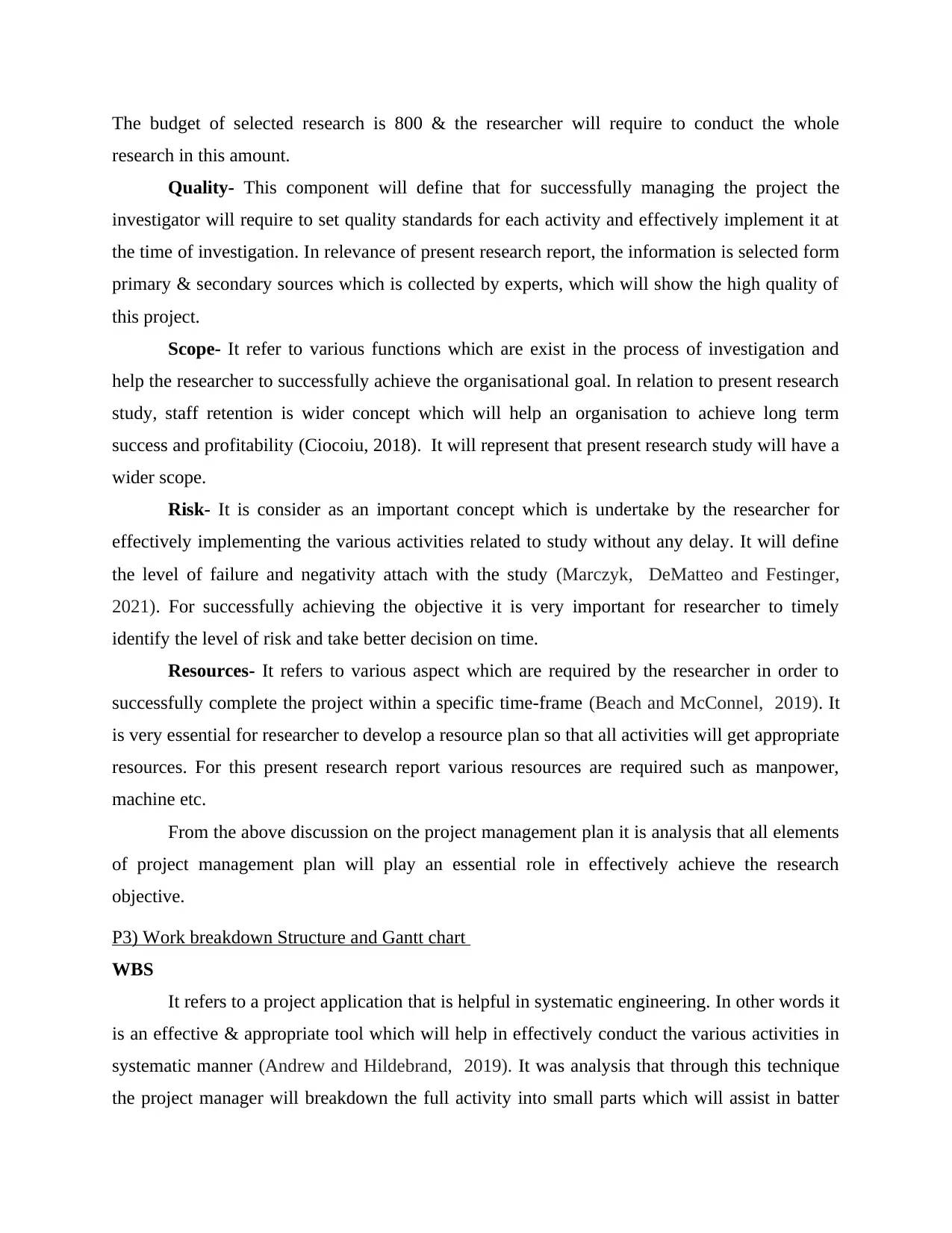
The budget of selected research is 800 & the researcher will require to conduct the whole
research in this amount.
Quality- This component will define that for successfully managing the project the
investigator will require to set quality standards for each activity and effectively implement it at
the time of investigation. In relevance of present research report, the information is selected form
primary & secondary sources which is collected by experts, which will show the high quality of
this project.
Scope- It refer to various functions which are exist in the process of investigation and
help the researcher to successfully achieve the organisational goal. In relation to present research
study, staff retention is wider concept which will help an organisation to achieve long term
success and profitability (Ciocoiu, 2018). It will represent that present research study will have a
wider scope.
Risk- It is consider as an important concept which is undertake by the researcher for
effectively implementing the various activities related to study without any delay. It will define
the level of failure and negativity attach with the study (Marczyk, DeMatteo and Festinger,
2021). For successfully achieving the objective it is very important for researcher to timely
identify the level of risk and take better decision on time.
Resources- It refers to various aspect which are required by the researcher in order to
successfully complete the project within a specific time-frame (Beach and McConnel, 2019). It
is very essential for researcher to develop a resource plan so that all activities will get appropriate
resources. For this present research report various resources are required such as manpower,
machine etc.
From the above discussion on the project management plan it is analysis that all elements
of project management plan will play an essential role in effectively achieve the research
objective.
P3) Work breakdown Structure and Gantt chart
WBS
It refers to a project application that is helpful in systematic engineering. In other words it
is an effective & appropriate tool which will help in effectively conduct the various activities in
systematic manner (Andrew and Hildebrand, 2019). It was analysis that through this technique
the project manager will breakdown the full activity into small parts which will assist in batter
research in this amount.
Quality- This component will define that for successfully managing the project the
investigator will require to set quality standards for each activity and effectively implement it at
the time of investigation. In relevance of present research report, the information is selected form
primary & secondary sources which is collected by experts, which will show the high quality of
this project.
Scope- It refer to various functions which are exist in the process of investigation and
help the researcher to successfully achieve the organisational goal. In relation to present research
study, staff retention is wider concept which will help an organisation to achieve long term
success and profitability (Ciocoiu, 2018). It will represent that present research study will have a
wider scope.
Risk- It is consider as an important concept which is undertake by the researcher for
effectively implementing the various activities related to study without any delay. It will define
the level of failure and negativity attach with the study (Marczyk, DeMatteo and Festinger,
2021). For successfully achieving the objective it is very important for researcher to timely
identify the level of risk and take better decision on time.
Resources- It refers to various aspect which are required by the researcher in order to
successfully complete the project within a specific time-frame (Beach and McConnel, 2019). It
is very essential for researcher to develop a resource plan so that all activities will get appropriate
resources. For this present research report various resources are required such as manpower,
machine etc.
From the above discussion on the project management plan it is analysis that all elements
of project management plan will play an essential role in effectively achieve the research
objective.
P3) Work breakdown Structure and Gantt chart
WBS
It refers to a project application that is helpful in systematic engineering. In other words it
is an effective & appropriate tool which will help in effectively conduct the various activities in
systematic manner (Andrew and Hildebrand, 2019). It was analysis that through this technique
the project manager will breakdown the full activity into small parts which will assist in batter
Paraphrase This Document
Need a fresh take? Get an instant paraphrase of this document with our AI Paraphraser
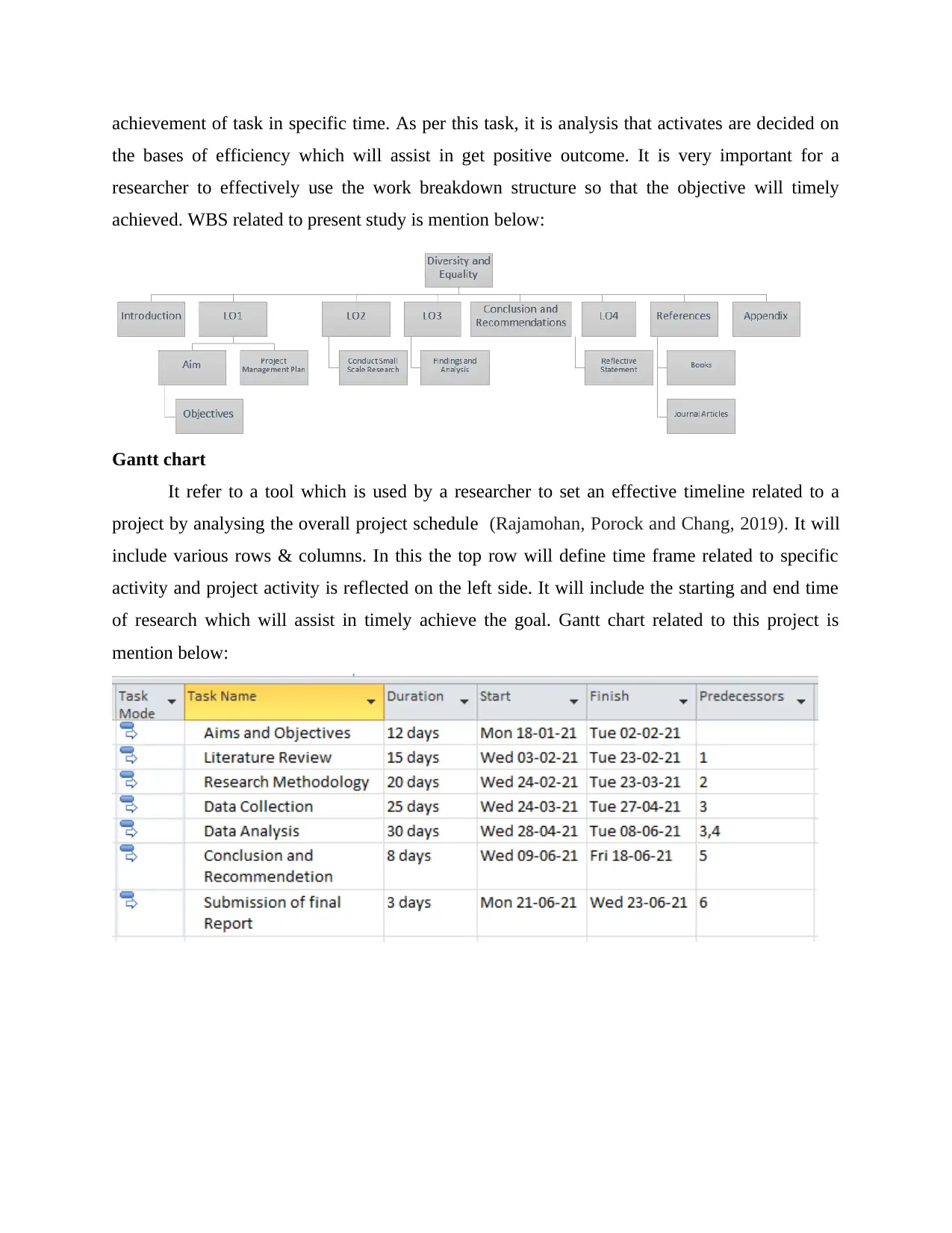
achievement of task in specific time. As per this task, it is analysis that activates are decided on
the bases of efficiency which will assist in get positive outcome. It is very important for a
researcher to effectively use the work breakdown structure so that the objective will timely
achieved. WBS related to present study is mention below:
Gantt chart
It refer to a tool which is used by a researcher to set an effective timeline related to a
project by analysing the overall project schedule (Rajamohan, Porock and Chang, 2019). It will
include various rows & columns. In this the top row will define time frame related to specific
activity and project activity is reflected on the left side. It will include the starting and end time
of research which will assist in timely achieve the goal. Gantt chart related to this project is
mention below:
the bases of efficiency which will assist in get positive outcome. It is very important for a
researcher to effectively use the work breakdown structure so that the objective will timely
achieved. WBS related to present study is mention below:
Gantt chart
It refer to a tool which is used by a researcher to set an effective timeline related to a
project by analysing the overall project schedule (Rajamohan, Porock and Chang, 2019). It will
include various rows & columns. In this the top row will define time frame related to specific
activity and project activity is reflected on the left side. It will include the starting and end time
of research which will assist in timely achieve the goal. Gantt chart related to this project is
mention below:
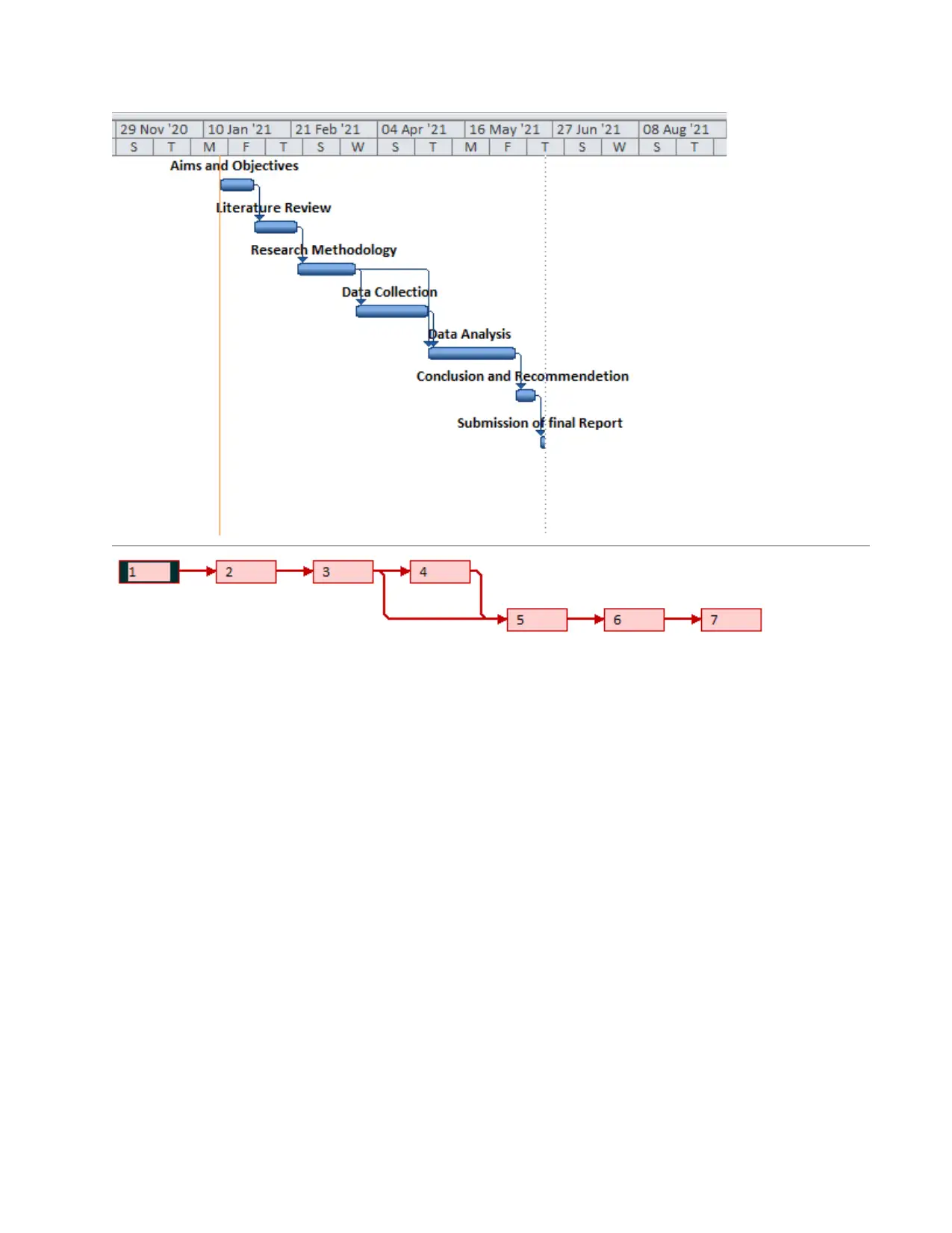
⊘ This is a preview!⊘
Do you want full access?
Subscribe today to unlock all pages.

Trusted by 1+ million students worldwide
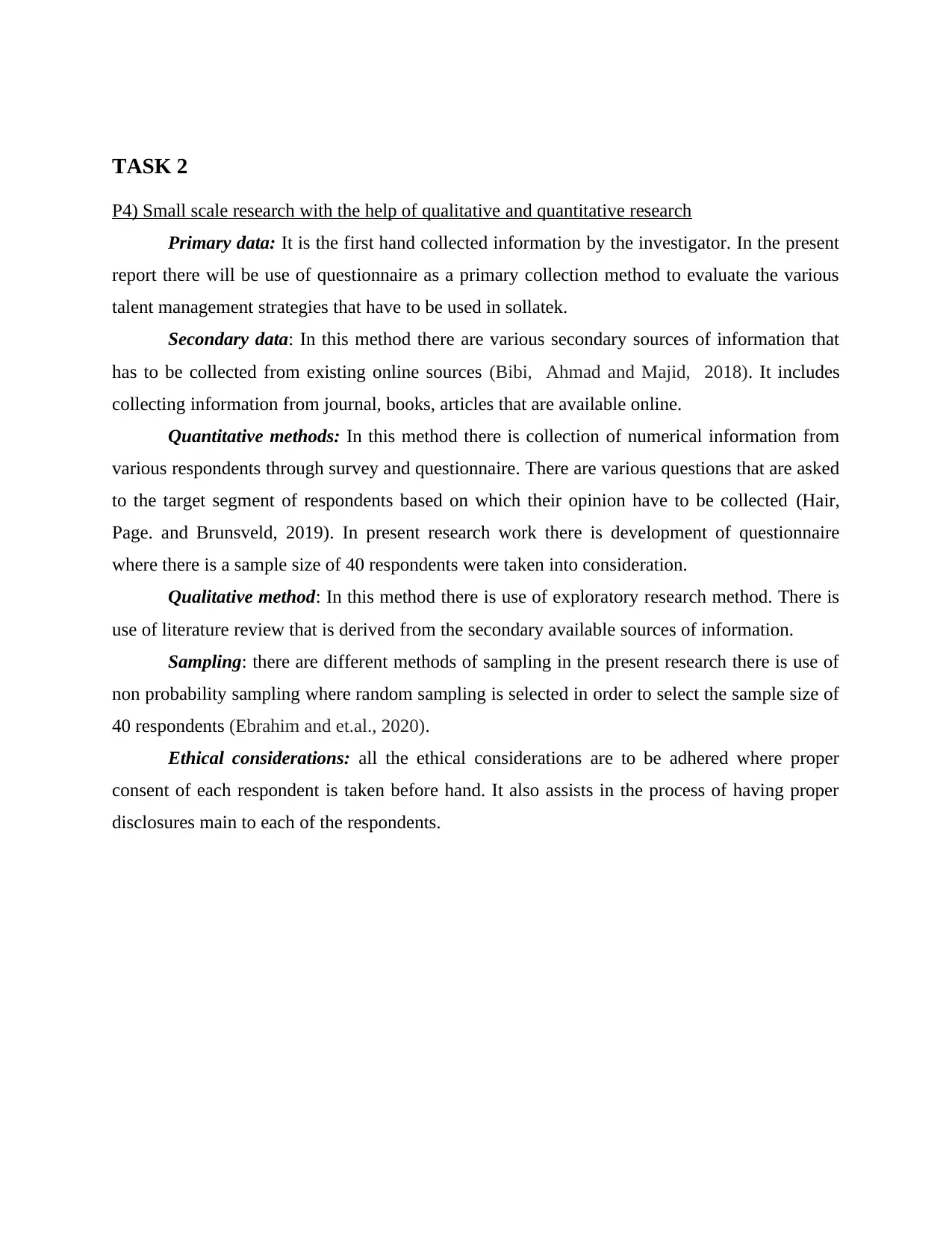
TASK 2
P4) Small scale research with the help of qualitative and quantitative research
Primary data: It is the first hand collected information by the investigator. In the present
report there will be use of questionnaire as a primary collection method to evaluate the various
talent management strategies that have to be used in sollatek.
Secondary data: In this method there are various secondary sources of information that
has to be collected from existing online sources (Bibi, Ahmad and Majid, 2018). It includes
collecting information from journal, books, articles that are available online.
Quantitative methods: In this method there is collection of numerical information from
various respondents through survey and questionnaire. There are various questions that are asked
to the target segment of respondents based on which their opinion have to be collected (Hair,
Page. and Brunsveld, 2019). In present research work there is development of questionnaire
where there is a sample size of 40 respondents were taken into consideration.
Qualitative method: In this method there is use of exploratory research method. There is
use of literature review that is derived from the secondary available sources of information.
Sampling: there are different methods of sampling in the present research there is use of
non probability sampling where random sampling is selected in order to select the sample size of
40 respondents (Ebrahim and et.al., 2020).
Ethical considerations: all the ethical considerations are to be adhered where proper
consent of each respondent is taken before hand. It also assists in the process of having proper
disclosures main to each of the respondents.
P4) Small scale research with the help of qualitative and quantitative research
Primary data: It is the first hand collected information by the investigator. In the present
report there will be use of questionnaire as a primary collection method to evaluate the various
talent management strategies that have to be used in sollatek.
Secondary data: In this method there are various secondary sources of information that
has to be collected from existing online sources (Bibi, Ahmad and Majid, 2018). It includes
collecting information from journal, books, articles that are available online.
Quantitative methods: In this method there is collection of numerical information from
various respondents through survey and questionnaire. There are various questions that are asked
to the target segment of respondents based on which their opinion have to be collected (Hair,
Page. and Brunsveld, 2019). In present research work there is development of questionnaire
where there is a sample size of 40 respondents were taken into consideration.
Qualitative method: In this method there is use of exploratory research method. There is
use of literature review that is derived from the secondary available sources of information.
Sampling: there are different methods of sampling in the present research there is use of
non probability sampling where random sampling is selected in order to select the sample size of
40 respondents (Ebrahim and et.al., 2020).
Ethical considerations: all the ethical considerations are to be adhered where proper
consent of each respondent is taken before hand. It also assists in the process of having proper
disclosures main to each of the respondents.
Paraphrase This Document
Need a fresh take? Get an instant paraphrase of this document with our AI Paraphraser
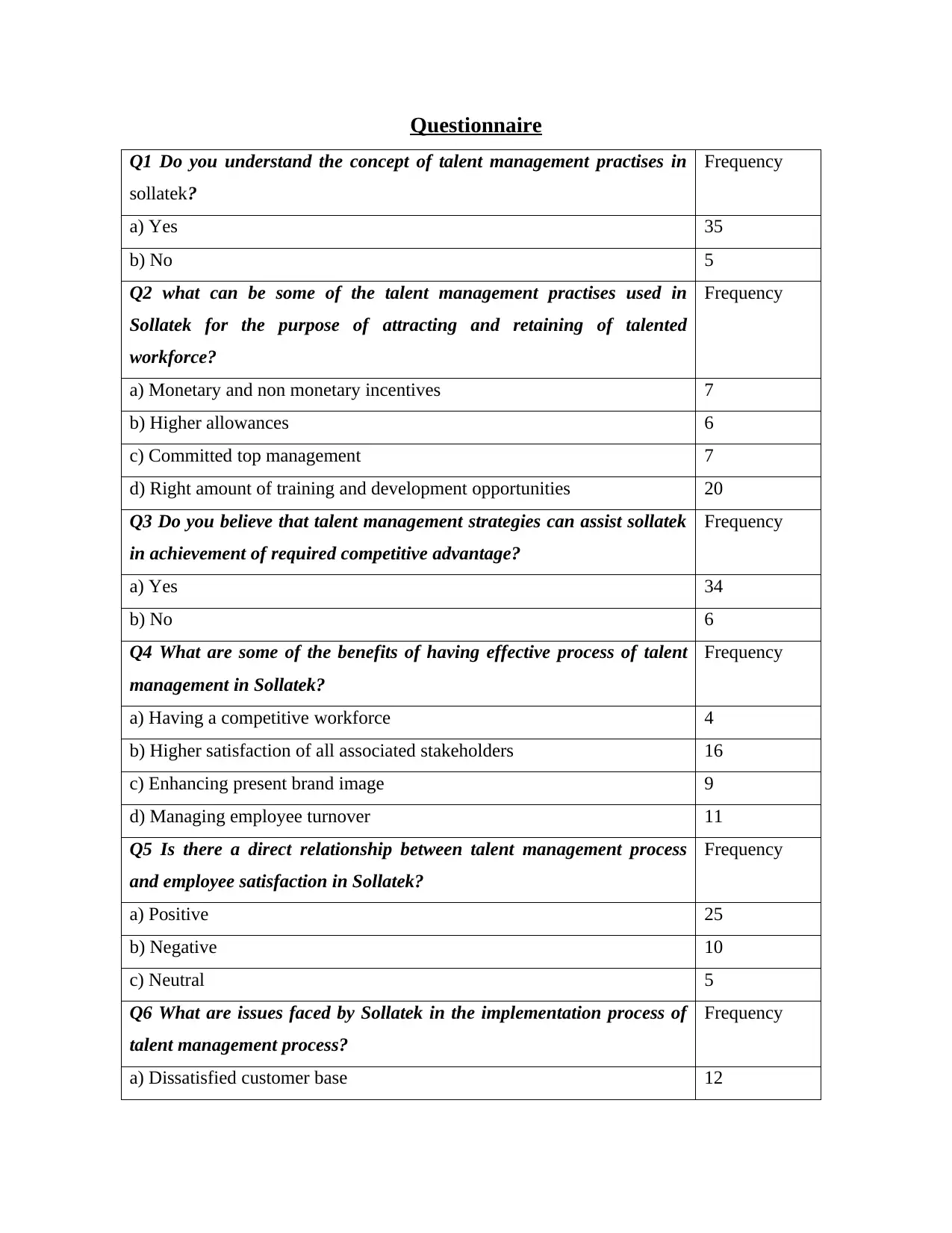
Questionnaire
Q1 Do you understand the concept of talent management practises in
sollatek?
Frequency
a) Yes 35
b) No 5
Q2 what can be some of the talent management practises used in
Sollatek for the purpose of attracting and retaining of talented
workforce?
Frequency
a) Monetary and non monetary incentives 7
b) Higher allowances 6
c) Committed top management 7
d) Right amount of training and development opportunities 20
Q3 Do you believe that talent management strategies can assist sollatek
in achievement of required competitive advantage?
Frequency
a) Yes 34
b) No 6
Q4 What are some of the benefits of having effective process of talent
management in Sollatek?
Frequency
a) Having a competitive workforce 4
b) Higher satisfaction of all associated stakeholders 16
c) Enhancing present brand image 9
d) Managing employee turnover 11
Q5 Is there a direct relationship between talent management process
and employee satisfaction in Sollatek?
Frequency
a) Positive 25
b) Negative 10
c) Neutral 5
Q6 What are issues faced by Sollatek in the implementation process of
talent management process?
Frequency
a) Dissatisfied customer base 12
Q1 Do you understand the concept of talent management practises in
sollatek?
Frequency
a) Yes 35
b) No 5
Q2 what can be some of the talent management practises used in
Sollatek for the purpose of attracting and retaining of talented
workforce?
Frequency
a) Monetary and non monetary incentives 7
b) Higher allowances 6
c) Committed top management 7
d) Right amount of training and development opportunities 20
Q3 Do you believe that talent management strategies can assist sollatek
in achievement of required competitive advantage?
Frequency
a) Yes 34
b) No 6
Q4 What are some of the benefits of having effective process of talent
management in Sollatek?
Frequency
a) Having a competitive workforce 4
b) Higher satisfaction of all associated stakeholders 16
c) Enhancing present brand image 9
d) Managing employee turnover 11
Q5 Is there a direct relationship between talent management process
and employee satisfaction in Sollatek?
Frequency
a) Positive 25
b) Negative 10
c) Neutral 5
Q6 What are issues faced by Sollatek in the implementation process of
talent management process?
Frequency
a) Dissatisfied customer base 12
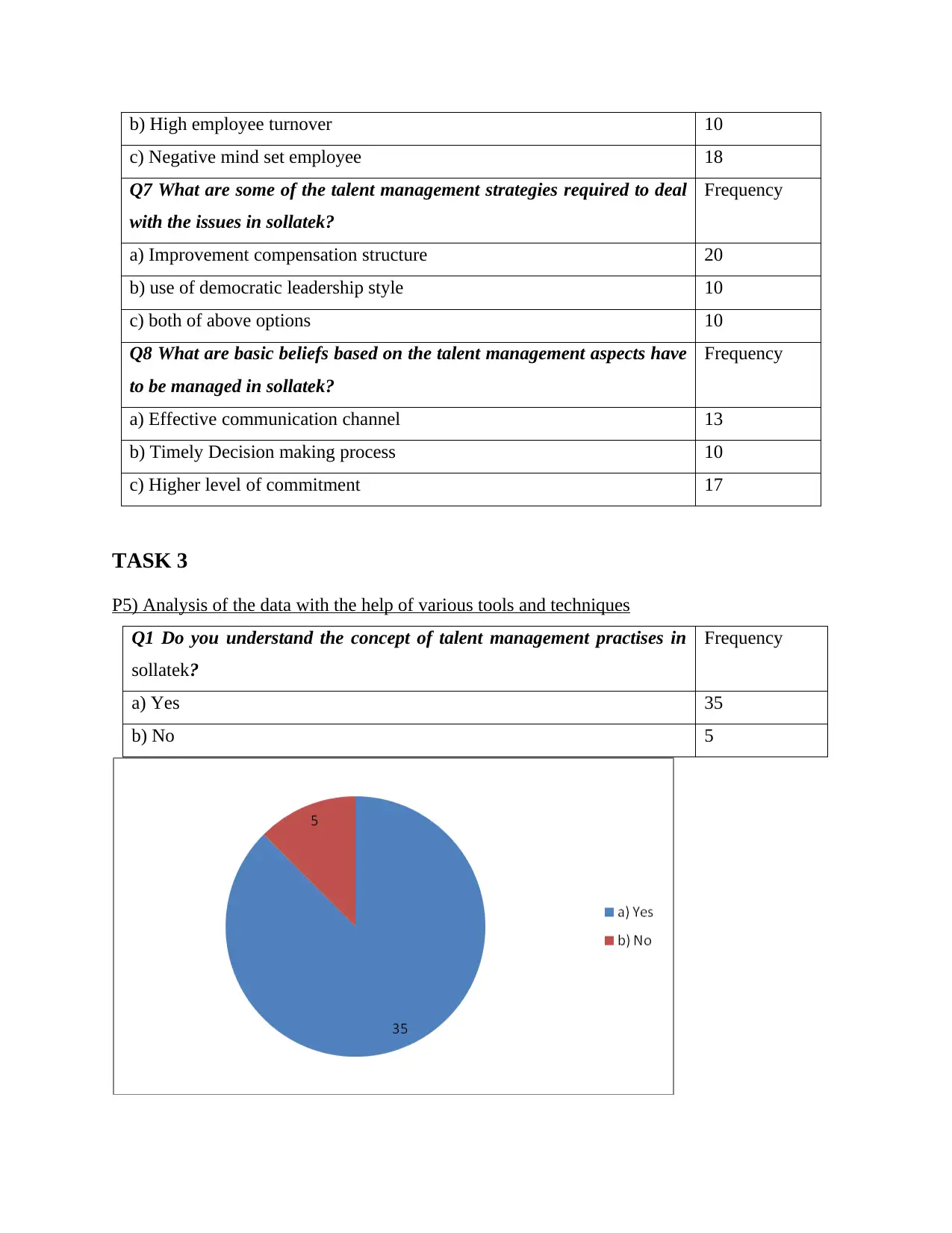
b) High employee turnover 10
c) Negative mind set employee 18
Q7 What are some of the talent management strategies required to deal
with the issues in sollatek?
Frequency
a) Improvement compensation structure 20
b) use of democratic leadership style 10
c) both of above options 10
Q8 What are basic beliefs based on the talent management aspects have
to be managed in sollatek?
Frequency
a) Effective communication channel 13
b) Timely Decision making process 10
c) Higher level of commitment 17
TASK 3
P5) Analysis of the data with the help of various tools and techniques
Q1 Do you understand the concept of talent management practises in
sollatek?
Frequency
a) Yes 35
b) No 5
c) Negative mind set employee 18
Q7 What are some of the talent management strategies required to deal
with the issues in sollatek?
Frequency
a) Improvement compensation structure 20
b) use of democratic leadership style 10
c) both of above options 10
Q8 What are basic beliefs based on the talent management aspects have
to be managed in sollatek?
Frequency
a) Effective communication channel 13
b) Timely Decision making process 10
c) Higher level of commitment 17
TASK 3
P5) Analysis of the data with the help of various tools and techniques
Q1 Do you understand the concept of talent management practises in
sollatek?
Frequency
a) Yes 35
b) No 5
⊘ This is a preview!⊘
Do you want full access?
Subscribe today to unlock all pages.

Trusted by 1+ million students worldwide
1 out of 27
Related Documents
Your All-in-One AI-Powered Toolkit for Academic Success.
+13062052269
info@desklib.com
Available 24*7 on WhatsApp / Email
![[object Object]](/_next/static/media/star-bottom.7253800d.svg)
Unlock your academic potential
Copyright © 2020–2025 A2Z Services. All Rights Reserved. Developed and managed by ZUCOL.





